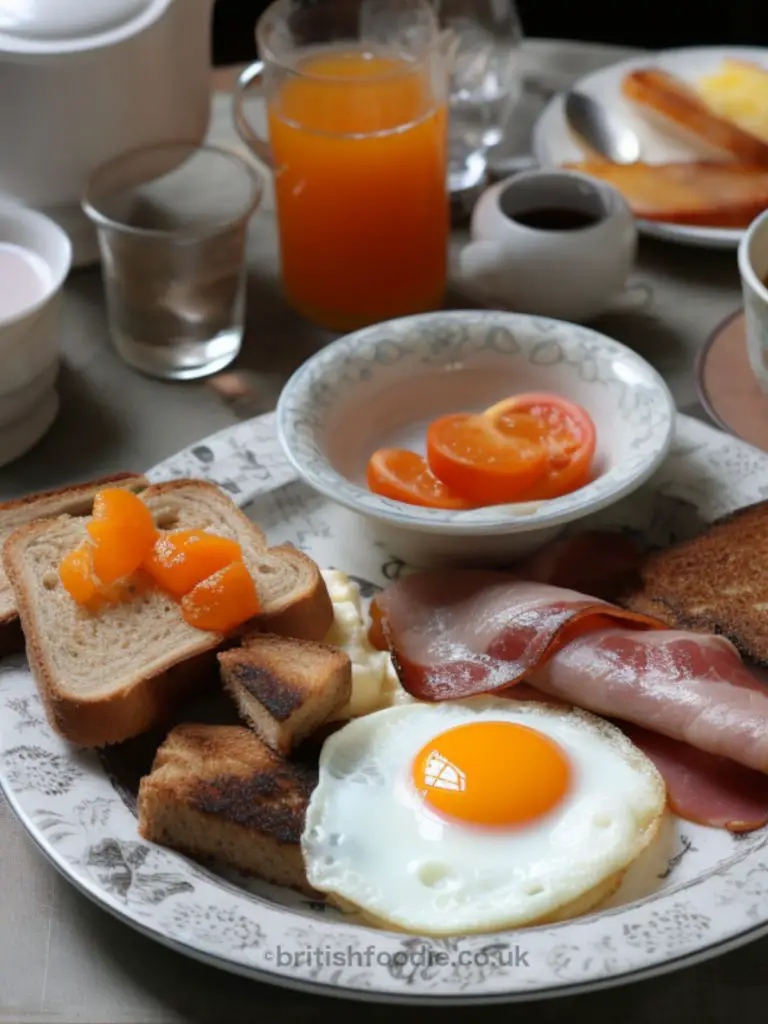The Welsh Breakfast: A Hearty Tradition with Coastal Flavours
Discover what makes a Welsh breakfast unique—from laverbread to cockles, this coastal twist on the classic UK fry-up is full of tradition and flavour.

Introduction to the UK’s Full Breakfast Tradition
Across the United Kingdom, breakfast isn’t just the first meal of the day—it’s a cultural statement. Whether you’re in England, Scotland, Ireland, or Wales, the “full breakfast” is a beloved morning feast loaded with hearty ingredients. Each region adds its personality, shaped by local produce and culinary history.
While the English breakfast often takes the spotlight with baked beans and black pudding, the Welsh breakfast remains a hidden gem. Rooted in seaside communities and miner traditions, it’s a plate of food that tells a story—one filled with rich flavours, sea-sourced ingredients, and national pride.
Core Components of a Traditional Welsh Breakfast
The Familiar Staples Shared Across the UK
A Welsh breakfast shares a solid foundation with its British cousins.
Bacon and Sausages: Sizzling Centrepieces
Crisp, thick-cut bacon—often smoked and locally cured—is a staple. Alongside it are pork sausages or a unique twist: Glamorgan sausages, made with leeks, cheese, and breadcrumbs, offering a vegetarian delight packed with savoury flavour.
Eggs, Tomatoes, and Mushrooms
Fried, scrambled, or poached eggs bring warmth and protein. Grilled tomatoes and buttery mushrooms lend earthy sweetness and texture, completing the classic trio.
Toast and Fried Bread
Either golden-browned fried bread or crusty toast gives that satisfying crunch. It’s the ideal canvas for spreading butter or mopping up runny yolks. Get the beans on toast recipe here ->
The Welsh Twist: Signature Coastal Additions
Laverbread (Bara Lawr): The Soul of the Sea
The defining feature of a Welsh breakfast is laverbread, made from boiled seaweed (laver) that’s minced and often mixed with oats before being fried in bacon fat. Rich in iodine and iron, it’s a briny, umami-packed bite with a jelly-like texture—unusual to newcomers, beloved by locals. Get our British foodie Welsh cockles and laverbread recipe here ->
Cockles: The Coastal Delicacy

These small, salty clams are a nod to Wales’ coastal roots. Usually served warm and seasoned, they offer a delightful briny contrast that enhances the plate’s savoury profile.
Welsh Cheeses: Caerphilly and Beyond
Mild yet tangy, Caerphilly cheese is sometimes added in slices or crumbled into scrambled eggs. Other local varieties make appearances depending on the region and chef.
Comparing the Welsh Breakfast to Other UK Variants
How It Differs from a Full English
A traditional Full English features black pudding, baked beans, and hash browns—items not typically found on the Welsh plate. Instead, Welsh breakfasts highlight seafood and unique cheeses, reflecting a closer bond to the land and sea.
Contrasts with the Scottish Breakfast
Scotland’s fry-ups include haggis and potato scones. Wales prefers seaweed and cockles, showcasing a different kind of rustic charm.
Irish Fry vs. Welsh Coastal Simplicity
Ireland leans on soda bread and white pudding. Wales? It’s all about laverbread and sea-sourced extras, keeping things lighter and more coastal.
The Cultural Significance of the Welsh Breakfast
Miner’s Meals and the Legacy of Laverbread
Laverbread was once the sustenance of coal miners—cheap, nutrient-rich, and easy to prepare. It became a breakfast tradition passed down through generations.
Glamorgan Sausage and Vegetarian Traditions
Though today’s breakfast often includes meat, vegetarianism isn’t new in Wales. The Glamorgan sausage is a testament to how Welsh cuisine celebrates vegetables like leeks and dairy products like cheese.
Welsh Breakfast in Modern Tourism
Travellers in Cardiff, Swansea, and along the Gower Peninsula are increasingly discovering this coastal twist on breakfast. Seaside cafés, farmer’s markets, and even luxury B&Bs now proudly serve traditional Welsh breakfasts to curious visitors.
DIY Recipe: Crafting Your Welsh Breakfast at Home
Ingredients and Shopping Tips
- Laverbread (fresh or dried)
- Rolled oats
- Cockles (canned or fresh)
- Streaky bacon
- Free-range eggs
- Mushrooms and tomatoes
- Caerphilly cheese
- Butter or bacon fat
Step-by-Step Instructions
- Prepare laverbread: Mix with oats and form patties. Pan-fry until golden.
- Cook bacon and sausages to preference.
- Grill mushrooms and tomatoes with a pinch of salt.
- Poach or fry eggs until the yolk is just set.
- Heat the cockles gently and plate alongside the laverbread cakes.
- Serve hot with toast and optional Caerphilly cheese.
Vegan and Modern Adaptations
Try plant-based sausages, vegan cheese, and seaweed flakes instead of laverbread if sourcing is tricky.
Nutritional Perspective: Health Benefits and Considerations
Seaweed’s Nutrient Power
Laverbread, the star of the Welsh breakfast, is more than just a cultural relic—it’s a nutritional powerhouse. Rich in iodine, iron, calcium, and B vitamins, it supports thyroid function, boosts energy levels, and strengthens bones. It’s also low in calories and fat, making it one of the healthiest ingredients on the plate.
Balancing Tradition with Wellness
Of course, like any full breakfast, the traditional Welsh version can be high in fat and sodium, especially when fried in bacon grease or paired with rich cheeses. For a lighter version, try grilling ingredients, using leaner meats, or opting for vegetarian variations. You’ll still get that iconic taste with fewer health trade-offs.
Food Debates and Modern Takes
Baked Beans: Yes or No?
One point of contention among food lovers is whether baked beans belong on a Welsh breakfast plate. Purists might scoff, but modern diners often appreciate the extra texture and sweetness. While not traditional, beans are showing up more often—especially in tourist cafes.
Embracing Change While Honouring Tradition
From vegan Glamorgan sausages to gluten-free laverbread patties, culinary innovation is reshaping how the Welsh breakfast is enjoyed. However, the soul of the dish—its reliance on local, coastal, and comforting ingredients—remains steadfast.
Best Places to Try a Real Welsh Breakfast
Coastal Cafés in Swansea and Cardiff
If you’re after the real deal, head to Swansea Market or the Cardiff Central Market—both serve authentic plates that include fresh cockles and laverbread. Nearby cafés like The Welsh House or The Shed on the Gower Peninsula are also well-loved by locals.
Welsh Markets and Farm-to-Table Spots
Inland towns and countryside inns are also serving up locally sourced Welsh breakfasts. Places like Llanerch Vineyard Hotel or The Felin Fach Griffin near Brecon are famous for blending gourmet flair with time-honoured ingredients.
FAQs About the Welsh Breakfast
Laverbread is made from boiled laver seaweed, mashed into a paste, and often sold canned or frozen in Welsh shops. Outside of Wales, you can order it online from speciality food retailers or seafood suppliers.
Absolutely. The Glamorgan sausage is a traditional vegetarian option, made from leeks, cheese, and breadcrumbs. You can also include mushrooms, grilled tomatoes, and vegan versions of laverbread.
It depends on how it’s prepared. With nutrient-rich laverbread and lean proteins like cockles, it can be healthier. But frying in animal fat and adding cheese can tip the scales in the other direction.
Not always. While traditional Welsh breakfasts often include cockles, they’re not a requirement. Many home cooks leave them out if they’re unavailable or if guests prefer a land-based option.
A strong cup of Welsh tea (like Glengettie) is the classic choice. Some enjoy it with a splash of milk, while others prefer black tea to balance the meal’s savoury profile.
Laverbread has been a part of Welsh cuisine for centuries, especially in coastal areas like Pembrokeshire and Gower. It became popular among coal miners for its high mineral content and affordability.
Conclusion: Celebrating the Spirit of Welsh Cuisine
The Welsh breakfast is more than just food—it’s a living snapshot of Welsh identity. From miners’ tables to seaside cafés, each component tells a story of resilience, geography, and tradition. With laverbread’s oceanic depth, cockles’ coastal charm, and the comforting foundation of bacon and eggs, this unique breakfast invites you to explore a lesser-known but deeply loved culinary tradition.
Whether you’re visiting Wales or simply cooking at home, don’t miss the chance to try this hearty, flavorful, and unforgettable meal. You may just discover your new favourite way to start the day.
